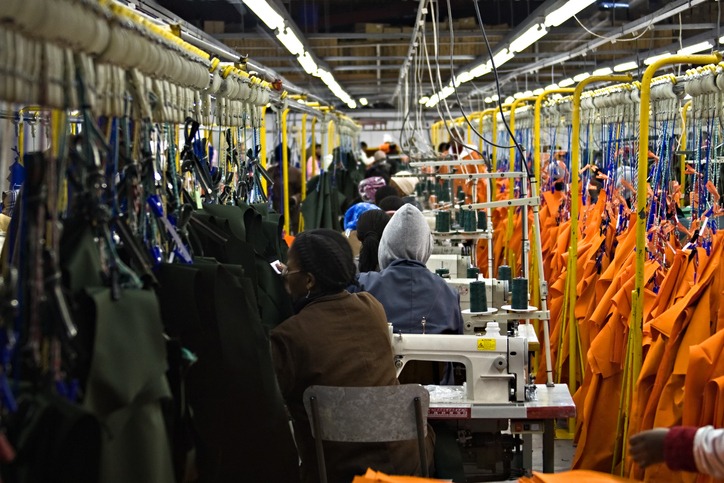In the ever-evolving landscape of fashion, ‘fast fashion’ has emerged as a term that encapsulates the quick turnaround of new styles from the catwalk to consumers at affordable prices. This phenomenon has not only revolutionized the way people dress but has also profoundly impacted the clothing manufacturing sector. Fast fashion, characterized by its inexpensive, on-trend garments, has become ubiquitous in modern society, with major brands leading the charge in a race to deliver the latest fashion trends to consumers.
The allure of fast fashion lies in its ability to rapidly produce clothing that reflects the latest styles and fashions, catering to a consumer base eager for new and affordable apparel. However, the impact of this business model on clothing manufacturing is multifaceted, encompassing economic, environmental, and social dimensions. The fast-paced nature of this industry necessitates a constant churning of new products, which in turn requires an efficient, cost-effective, and often relentless manufacturing process.
In this article, we will delve into the various aspects of how fast fashion has reshaped the clothing manufacturing landscape. From its origins and rapid growth to the economic ramifications and environmental toll, we will explore the comprehensive impact of this industry. Furthermore, we will examine the social and ethical implications of fast fashion, particularly in relation to the working conditions and practices in manufacturing hubs around the world. Additionally, we will look at how the industry is responding to growing concerns about sustainability and what the future may hold for the intersection of fashion and manufacturing.
History and Evolution of Fast Fashion
Origins in the Fashion Industry
The concept of fast fashion is relatively modern, but its roots can be traced back to the post-World War II era, particularly in the United States and Europe. The fashion industry began to shift from a system of seasonal collections to a more rapid production model. This change was initially driven by the growing consumer desire for new and accessible fashion, stemming from increased disposable incomes and a burgeoning interest in pop culture and current trends.
The 1960s and 1970s marked significant turning points. The ‘mod’ fashion trend in the UK, characterized by mini skirts and bold geometric patterns, is an early example of fast fashion. Retailers began to understand the potential of quickly producing garments that mimicked high-fashion designs seen in magazines and on runways.
Key Developments and Milestones
- The Rise of Offshore Manufacturing: In the 1980s and 1990s, many Western fashion brands started moving their manufacturing offshore. Countries like China, Bangladesh, and India, with their lower labor costs, became attractive locations. This shift was a critical development in the history of fast fashion, as it allowed brands to reduce costs and speed up production times.
- Technological Advancements: The advent of new technologies in the late 20th and early 21st centuries played a pivotal role. Computer-aided design (CAD) systems and improved supply chain management software enabled faster design, production, and distribution processes. This era also saw the rise of e-commerce, making fast fashion even more accessible to a global audience.
- Zara and the Quick Response Model: Zara, a Spanish retailer, emerged as a paradigm-shifter in the fast fashion industry. Its quick response (QR) model, which could take a product from design to store in just a few weeks, was revolutionary. Zara’s success demonstrated the viability and profitability of this model, prompting other retailers to adopt similar strategies.
- 21st Century Boom: The early 2000s saw an explosion of fast fashion. Brands like H&M, Forever 21, and Topshop expanded globally, offering trendy clothes at low prices. The industry’s growth was fueled by an increasingly connected world, where trends seen on social media and celebrity culture could be quickly translated into mass-produced garments.
- Sustainability and Ethical Concerns: In recent years, there has been a growing awareness of the negative impacts of fast fashion, including environmental damage and poor labor conditions. This has led to a push for more sustainable practices within the industry and the rise of ‘slow fashion’ movements that emphasize quality, longevity, and ethical production.
The evolution of fast fashion is a story of innovation, globalization, and consumer culture. Its history reflects broader societal changes and challenges, setting the stage for a future where the industry must balance speed and efficiency with sustainability and ethics. As we move forward, the legacy of fast fashion’s rapid rise will undoubtedly continue to shape the clothing manufacturing landscape, presenting both challenges and opportunities for brands, consumers, and policymakers alike.
Fast Fashion’s Manufacturing Process
Overview of Production Techniques
Fast fashion’s manufacturing process is distinguished by its speed, efficiency, and ability to capitalize on trends as swiftly as possible. This approach contrasts sharply with traditional fashion production cycles, which are typically slower and more focused on seasonality. Key aspects of fast fashion manufacturing include:
- Trend Identification: Fast fashion brands excel at quickly identifying and responding to current trends. They use advanced data analytics, social media monitoring, and feedback from store managers to pinpoint consumer preferences in real time.
- Rapid Design Process: Once a trend is identified, designers create patterns and prototypes at an accelerated pace. Computer-aided design (CAD) software plays a crucial role here, allowing for quick adjustments and immediate sharing of designs with manufacturing facilities.
- Streamlined Production: Production lines in fast fashion factories are optimized for speed. This involves using time-saving techniques, such as simplified garment patterns, versatile fabric selections, and efficient assembly processes. Automation and robotics are increasingly being integrated to further enhance production speed.
- Flexible Supply Chain Management: Fast fashion brands often employ a flexible and responsive supply chain strategy. They maintain strong relationships with a diverse network of suppliers who can quickly source materials and start production lines. Just-in-time manufacturing is a common practice, reducing inventory costs and waste.
- Agile Distribution: Once manufactured, the garments are rapidly distributed through an efficient logistics network. The use of advanced inventory management systems ensures that products reach the stores while the trend is still at its peak.
Comparison with Traditional Manufacturing Methods
Traditional clothing manufacturing methods differ significantly from the fast fashion model, primarily in terms of pace, production volume, and design longevity:
- Seasonal Collections: Traditional fashion brands typically work on seasonal collections, planning months in advance. This slower pace allows for more attention to detail in both design and manufacturing but lacks the agility to adapt quickly to changing trends.
- Quality Over Quantity: The traditional model often emphasizes higher quality materials and craftsmanship. This results in more durable products but also higher costs and longer production times.
- Smaller Production Batches: Unlike fast fashion, which thrives on large volumes to meet constant demand, traditional manufacturers often produce smaller batches. This approach reduces the risk of unsold inventory but lacks the cost-effectiveness of mass production.
- Long-Term Supplier Relationships: While both models rely on global supply chains, traditional fashion brands often have longer-standing relationships with specific suppliers, focusing on quality and ethical manufacturing practices.
- Sustainable Practices: Traditional methods are generally more conducive to sustainable practices. These include using eco-friendly materials, ensuring fair labor practices, and reducing waste through more accurate demand forecasting.
The fast fashion manufacturing process, with its focus on speed and volume, has significantly impacted the clothing industry. While it has democratized fashion and made trendy clothing accessible, it also raises concerns about sustainability, quality, and ethical practices. As consumer awareness grows and technology evolves, the industry is being pushed towards a more balanced approach that incorporates the efficiency of fast fashion with the quality and sustainability of traditional methods. Future trends may see a fusion of these models, harnessing technological advancements to create a more sustainable, ethical, and responsive fashion industry.
Economic Impact of Fast Fashion
Effects on Global and Local Economies
Fast fashion has had a profound impact on both the global and local economies. Its influence is multifaceted, affecting everything from large-scale economic trends to the financial dynamics of individual communities.
- Global Retail Market: Fast fashion has significantly expanded the global retail market. Brands like Zara, H&M, and Forever 21 have become household names, generating billions in revenue and contributing to the growth of the global fashion industry. Their success has also driven other retailers to adopt fast fashion strategies, further expanding the market.
- Local Economies and Small Businesses: The rise of fast fashion has had mixed effects on local economies. On one hand, the entry of fast fashion brands into new markets can create jobs and stimulate local retail. On the other hand, these giants can overshadow local clothing businesses, often unable to compete with the low prices and rapid turnover of fast fashion items.
- Consumer Spending Habits: Fast fashion has changed consumer behavior. The availability of trendy, affordable clothing encourages more frequent purchases, increasing overall spending on apparel. However, this can also lead to decreased spending in other retail sectors, as a larger portion of disposable income is funneled into clothing.
Impact on Labor Markets in Manufacturing Countries
The labor markets in countries where fast fashion garments are manufactured have been significantly impacted.
- Job Creation: Fast fashion has created millions of jobs in manufacturing countries. Countries like Bangladesh, Vietnam, and Cambodia have seen their garment industries flourish due to demand from Western fashion brands. These jobs, often in urban areas, attract workers from rural regions and can contribute to urbanization and economic development.
- Working Conditions and Wages: While job creation is a positive outcome, the quality of these jobs is a major concern. Fast fashion’s demand for quick, cheap production has led to poor working conditions in many factories. Issues include long hours, low wages, lack of job security, and unsafe working environments. The 2013 Rana Plaza disaster in Bangladesh is a tragic example of the risks involved.
- Impact on Skill Development: The emphasis on speed and low costs means that workers are often engaged in repetitive, low-skill tasks, which limits opportunities for skill development and career advancement.
- Gender Dynamics: The garment industry is a significant employer of women in many developing countries. This has implications for gender dynamics, as it provides financial independence for many women. However, these workers are often among the most vulnerable, facing gender-specific challenges such as unequal pay and harassment.
The economic impact of fast fashion is complex and evolving. While it has stimulated growth in certain areas, it has also led to challenges and inequalities. Looking ahead, the industry is likely to continue evolving, influenced by technological advancements, changing consumer preferences, and a growing emphasis on sustainability and ethical practices. How fast fashion brands, governments, and consumers respond to these trends will shape the future economic landscape of the clothing manufacturing industry. Discover the NYC suburbs shopping scene. Visit How to Navigate Shopping and Retail in the NYC Suburbs? A Comprehensive Guide
Environmental Consequences
The environmental impact of fast fashion is significant and multifaceted, affecting various aspects of the ecosystem. This section explores the key areas where fast fashion has left its mark on the environment.
Resource Consumption and Waste
- Textile Production and Resource Use: The production of textiles for fast fashion consumes vast amounts of water, energy, and other resources. For instance, cotton, a commonly used material, is water-intensive. The Aral Sea in Central Asia, once one of the world’s largest lakes, has dramatically shrunk, partly due to the water used in cotton farming in the region.
- Synthetic Fibers and Microplastics: The use of synthetic fibers like polyester, which are derived from fossil fuels, has escalated in fast fashion. These materials shed microplastic fibers, which contribute to the growing problem of microplastics in oceans and waterways.
- Waste Generation: Fast fashion’s business model relies on a constant cycle of new products, leading to a significant amount of textile waste. Consumers, encouraged to frequently update their wardrobes, often dispose of clothing after a few wears. This results in millions of tons of clothing ending up in landfills each year, where they can take hundreds of years to decompose, especially synthetic fabrics.
Pollution and Carbon Footprint
- Greenhouse Gas Emissions: The fashion industry is a major contributor to global greenhouse gas emissions. The entire lifecycle of a garment, from production to transportation, contributes to its carbon footprint. The use of energy-intensive processes and long supply chains exacerbates this impact.
- Chemical Pollution: The dyeing and treatment of textiles involve harmful chemicals, which often end up polluting rivers and groundwater. In many manufacturing countries, regulations regarding chemical use and disposal are lax, leading to severe water pollution.
- Air Pollution:** Manufacturing and transportation processes involved in fast fashion emit various air pollutants, contributing to poor air quality and related health issues in many production regions.
Effects on Biodiversity
- Habitat Destruction: The expansion of agricultural land for textile production, such as cotton farming, can lead to habitat destruction. This not only affects land-based ecosystems but also impacts rivers and lakes due to diverted water sources and pollution.
- Pesticides and Fertilizers: The use of pesticides and fertilizers in cotton farming and other textile agriculture harms local flora and fauna. These chemicals can disrupt ecosystems, reduce biodiversity, and harm species that depend on these habitats.
- Impact on Marine Life: Microfibers from synthetic clothing contribute to ocean pollution, affecting marine biodiversity. These microfibers can be ingested by marine animals, leading to health problems and even death.
Social and Ethical Considerations
The social and ethical implications of fast fashion are critical and have garnered increasing attention in recent years. This section explores the conditions in manufacturing facilities, labor practices, and the evolving consumer perspective and awareness.
Working Conditions in Manufacturing Facilities
- Poor Working Conditions: Many fast fashion manufacturing facilities, particularly in developing countries, have been criticized for poor working conditions. This includes overcrowded and unsafe environments, as highlighted by tragic incidents like the Rana Plaza collapse in Bangladesh in 2013.
- Health Risks: Workers in these factories often face significant health risks due to exposure to harmful chemicals used in dyeing and treating fabrics, along with inadequate ventilation and protective equipment.
- Child and Forced Labor: Some factories have been found to employ child and forced labor. These practices are not only unethical but also violate numerous international laws and standards.
Ethical Concerns Around Labor Practices
- Low Wages: A common issue in the fast fashion industry is the low wages paid to workers. In many cases, these wages do not meet the living wage standards, preventing workers from having a decent standard of living.
- Long Working Hours and Lack of Rights: Factory workers often face long working hours, with little to no overtime pay. Additionally, there is a frequent lack of respect for workers’ rights, including the right to form or join trade unions and to collective bargaining.
- Gender Discrimination: The garment industry predominantly employs women, who are often subject to discrimination and gender-based violence. This includes unequal pay, harassment, and abuse.
The Consumer Perspective and Awareness
- Growing Awareness: There is a growing awareness among consumers about the social and ethical issues in the fashion industry. This has been propelled by media coverage, documentaries, and campaigns by various NGOs and activists.
- Demand for Transparency: Consumers are increasingly demanding transparency from brands on their manufacturing processes and labor practices. This is leading to more brands publishing details about their supply chains and efforts to ensure ethical practices.
- Shift Towards Ethical Fashion: A segment of consumers is shifting towards ethical fashion choices. This includes buying from brands that are committed to fair labor practices, choosing quality over quantity, and supporting sustainable and ethical fashion initiatives.
The Response of the Fashion Industry
The fashion industry’s response to the growing concerns around sustainability and ethics has been multifaceted. Many brands are increasingly incorporating sustainable practices and ethical considerations into their business models. This section explores these shifts and highlights case studies of brands leading the way.
Shifts towards Sustainable Practices
- Use of Sustainable Materials: An increasing number of fashion brands are shifting to sustainable materials like organic cotton, recycled polyester, and alternative materials such as Tencel and bamboo. These materials have a lower environmental impact compared to traditional textiles.
- Eco-friendly Production Methods: Brands are adopting more sustainable production methods. This includes water-saving dyeing techniques, energy-efficient manufacturing processes, and reduced use of harmful chemicals.
- Waste Reduction and Circular Fashion: Efforts are being made to reduce waste throughout the production process. Many brands are embracing the principles of circular fashion, which focuses on the longevity of garments, promoting recycling and upcycling, and creating clothing with the end of its life in mind.
- Carbon Footprint Reduction: There is a growing commitment to reducing carbon footprints across the industry. Brands are investing in renewable energy, optimizing supply chains, and exploring carbon offsetting initiatives.
Case Studies of Brands Adopting Ethical Practices
- Patagonia: Patagonia stands out for its commitment to environmental sustainability and ethical practices. The brand uses a high proportion of recycled and organic materials and is known for its repair and reuse program. Patagonia is also transparent about its supply chain and actively participates in environmental activism.
- Adidas and Parley for the Oceans: Adidas, in collaboration with Parley for the Oceans, creates shoes and apparel from recycled ocean plastic. This initiative not only helps reduce plastic waste in the oceans but also raises awareness about marine pollution.
- Stella McCartney: Stella McCartney is a luxury fashion brand that has been a pioneer in sustainable fashion. The brand is known for not using leather or fur and for its commitment to using sustainable materials, ethical manufacturing, and reducing its environmental impact.
- Everlane: Everlane focuses on transparency and ethical manufacturing. The brand provides detailed information about the factories where its clothes are made, including labor practices and the true cost of each garment.
- H&M’s Conscious Collection: H&M, a major player in fast fashion, has made efforts to address sustainability concerns. Their Conscious Collection uses sustainable materials like organic cotton and Tencel, and the company has set ambitious targets for using 100% recycled or sustainably sourced materials by 2030.
- Levi’s Water<Less Initiative: Levi’s has implemented the Water<Less initiative, which drastically reduces the amount of water used in the manufacturing process. This is particularly significant for products like jeans, which traditionally require large amounts of water to produce.
- The Road Ahead: The fashion industry’s shift towards sustainability and ethics is an ongoing journey. Challenges remain, particularly in balancing commercial objectives with environmental and social responsibilities. However, the increasing involvement of brands, technological advancements, and changing consumer attitudes are driving meaningful progress.
The future of the fashion industry lies in an approach that values not only aesthetics and profit but also the well-being of the environment and the people involved in the manufacturing process. As the industry continues to evolve, it will likely see a greater integration of sustainable practices, more collaborative efforts across the supply chain, and ongoing innovations that aim to reduce the environmental and social impact of fashion.
Consumer Trends and the Future of Fashion
The fashion industry is undergoing a significant transformation, driven largely by changing consumer attitudes towards sustainability and ethical practices. These shifts in consumer behavior are influencing the strategies of fashion brands and predicting new trends for the future of the industry.
Changing Consumer Attitudes Towards Sustainability:
Increased Awareness: Consumers are becoming more aware of the environmental and social impacts of their fashion choices. This awareness is fueled by media coverage, social media, documentaries, and activism.
Demand for Transparency and Ethical Practices: There is a growing demand for transparency in the fashion supply chain. Consumers are increasingly interested in where and how their clothes are made, and the labor conditions of workers.
Preference for Sustainable and Ethical Brands: More consumers are seeking out brands that align with their values. This includes brands that use sustainable materials, implement ethical labor practices, and have a lower environmental footprint.
Rise of the Conscious Consumer: A segment of the market, often referred to as the conscious consumer, is willing to pay a premium for sustainable and ethically made products. These consumers also tend to favor quality and durability over fast fashion trends.
Predictions for the Future of the Fashion Industry:
Sustainable and Circular Fashion Models: The industry is expected to continue shifting towards more sustainable and circular models. This includes designing products with their end-of-life in mind, focusing on recyclability and reusability.
Technological Integration: The integration of technology into fashion will likely increase, with advancements in sustainable materials, production processes, and digital retail experiences. Technologies like AI, 3D printing, and blockchain will play significant roles.
Customization and Personalization: Advances in technology will enable greater customization and personalization of clothing at scale, reducing waste associated with mass production and meeting consumer demand for unique products.
Growth of the Resale and Rental Markets: The resale and rental markets are expected to continue growing, driven by consumer interest in sustainability and affordability. This trend supports the idea of extending the life cycle of garments.
Shift in Marketing Narratives: Marketing narratives in the fashion industry will likely continue to evolve, with a greater emphasis on sustainability, ethical production, and corporate social responsibility.
Local and Artisanal Fashion: There may be a resurgence in local and artisanal fashion, as consumers seek authentic and unique items while supporting local economies and craftsmanship.
Regulatory Changes: Governments may introduce more regulations to promote sustainable practices in the fashion industry. This could include policies on waste reduction, recycling, and fair labor practices.
Consumer Education and Engagement: Brands and organizations will likely invest more in educating consumers about the importance of sustainable fashion and how to make responsible fashion choices.
The future of the fashion industry is poised to be markedly different from its past, with sustainability, ethics, and technology at its core. As consumer attitudes continue to evolve, the industry must adapt to meet these new demands and expectations. This shift presents both challenges and opportunities for brands, requiring innovation, transparency, and a commitment to sustainable practices. The industry’s ability to embrace these changes will be crucial in shaping its long-term sustainability and relevance in an increasingly conscious consumer market.
Conclusion
The impact of fast fashion on society and the environment paints a complex and multifaceted picture, stretching from its initial role in democratizing fashion to its evolution into a global phenomenon with far-reaching consequences.
Fast fashion’s economic impact has been significant, reshaping both global and local economies. It has been instrumental in creating job opportunities, yet it has also sparked concerns over labor practices and the competitive landscape of the market. Environmentally, the footprint of fast fashion is substantial, involving resource depletion, pollution, and loss of biodiversity. This alarming environmental toll has catalyzed a movement toward more sustainable practices within the industry.
On the social and ethical front, fast fashion has come under intense scrutiny. The working conditions and labor rights in manufacturing countries have raised serious questions, prompting widespread calls for reform. The fashion industry has started to respond to these challenges, gradually shifting towards more sustainable and ethical practices. This transition is being aided significantly by technological advancements, which are pivotal in facilitating change.
Consumer trends have also shifted noticeably. There’s a growing demand for transparency, sustainable products, and ethical practices, driven by changing consumer attitudes toward sustainability and ethics. This shift is prompting a significant transformation in the fashion industry.
Looking to the future, the path for fashion involves finding a balance between economic viability, environmental sustainability, and social responsibility. This requires a collaborative effort from various stakeholders, including brands, consumers, governments, and others. The industry is tasked with continuing to innovate, embracing new technologies and business models that prioritize sustainability and ethical considerations. Consumers play a vital role in this transformation by making informed choices and advocating for change.
As the fashion industry stands at a pivotal crossroads, the decisions made today will significantly shape its future. These choices will determine whether the industry can evolve into a force for positive change, promoting not only style and innovation but also environmental stewardship and social justice. The journey towards a more sustainable and ethical fashion industry is intricate and ongoing, but it’s an essential path for the health of our planet and the well-being of future generations.






